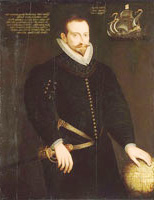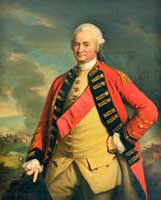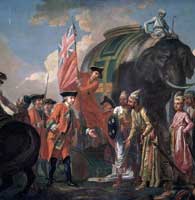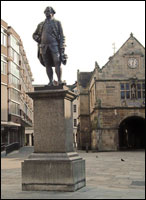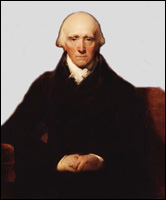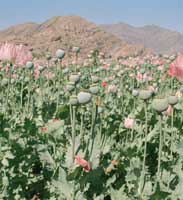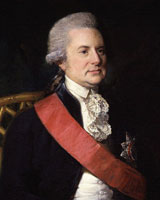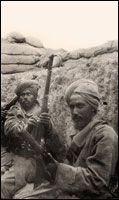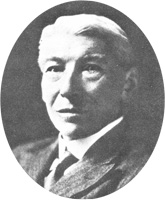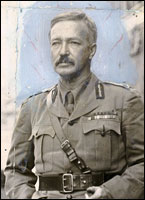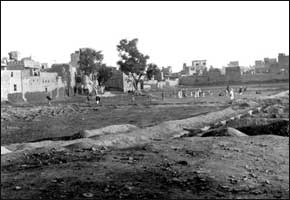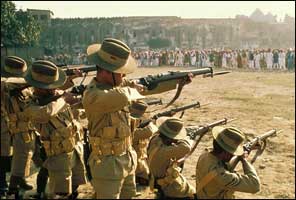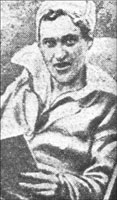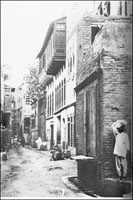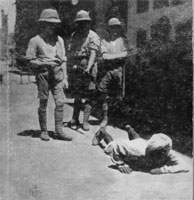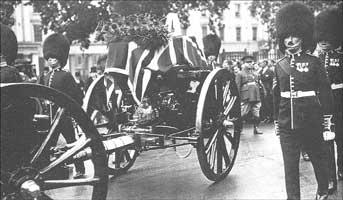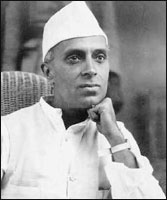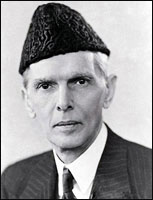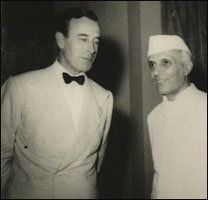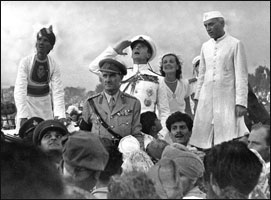THE GREEK EMPIRE OF ALEXANDER THE GREAT WAS THE OLD COVENANT LEOPARD (DANIEL 7:6). THE NEW COVENANT LEOPARD IS LEVIATHAN OR THE BRITISH EMPIRE (APOCALYPSE 13:2). |
Incredibly, Alexander the Great tried to conquer INDIA, but the Indians had advanced aircraft technology called VIMANAS, which terrified his soldiers, and he had to abandon his dream of world conquest:
That some lingering Vimanas were still around several thousand years after the destruction of Rama and Atlantis is evidenced by certain "UFO" accounts in ancient history. According to several researches such as Frank Edwards, when Alexander the Great invaded India in 326 B.C., two shining silvery shields spitting fire around the rims dived repeatedly on the Greek columns descending the mountain passes into the Punjab, stampeding the horses and elephants. The shields then returned to the skies and vanished. Alexander's men refused to go further than the river they had been attempting to cross, and Alexander's conquest of India was abandoned (Childress, Vimana: Aircraft of Ancient India and Atlantis, p. 298).
Incredibly advanced technology existed before the Great Flood, and India had remnants of that advanced technology. The 1957 Spoofnik 1 was probably an Indian Virmana.
Britannia's manifest destiny was always westward ho—not eastward to India....After the bloody Marian persecution, few Christians remained to fulfill that divine mandate!!
During the reign of terror of "Bloody Mary" Tudor, Elizabeth Tudor was arrested and imprisoned in the Tower of London. She never emerged alive from the Tower and was buried in the Thames.
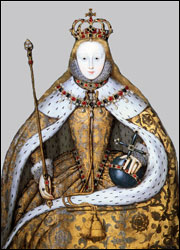 The Elizabeth double in her coronation robe. |
|
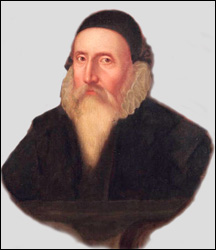
Dr. John Dee (1527–1608) was
the Court astrologer |
On November 17, 1558, the Elizabeth double succeeded her half-sister as sovereign. Many of the exiles returned to England, and John Dee became her chief "spiritual adviser."
John Dee was so full of demons that even the Catholics were afraid of him....The wizard worked closely with "Bloody Mary," Cardinal Pole, and "Bloody Bonner" in London:
Privy Councillors and commissioners routinely sat in on the examinations of major figures; the mathematician and astrologer Dr John Dee, ‘the great Coniurer’ (who was himself under suspicion for sorcery), took part in the preliminary examinations of John Philpot; and the London hosier and controversialist Miles Hogarde debated with Thomas Haukes. These preliminary examinations might go on for weeks or even months, depending on the importance of the accused, and often took on a gladiatorial character. (Duffy, Fires of Faith: Catholic England Under Mary Tudor, p. 102).
Those examinations always included TORTURE, as "Bloody Bonner" enjoyed torturing his victims!
Dee was the original "007" and the court astrologer for Shake-speare. He strongly believed that using the number 13 would defeat the plans of the Almighty!
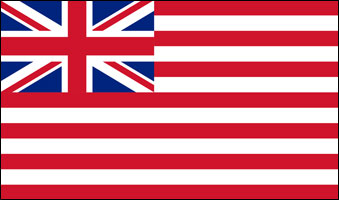 The official flag of Britannia, Inc., or the East India Company. |
|
 The East India Red Dragon. |
Amazingly, Portuguese Christopher Columbus called the New World natives Indians because Pope Nicholas V donated India to Portugal in 1455.
|
In 1744, a youth named Robert Clive was sent by the Company to India. Before the arrival of the British, India was a veritable paradise on earth:
In late 1665, traveling eastward from the Mughal court in Delhi, physician François Bernier arrived in Bengal to find a vast, populous delta, its myriad channels lined with vibrant towns and cities interspersed with fields of rice, sugar, corn, vegetables, mustard, and sesame. He declared it "the finest and most fruitful country in the world." Foreign merchants worked the wholesale markets, offering to buy produce in exchange for silver. They could not trade goods with the native businessmen, because Bengal was in need of virtually nothing. Its rice traveled to Sri Lanka (called Ceylon by the British) and the Maldives, its sugar to Arabia and Mesopotamia, and its silks to Europe; ships at its ports were loaded with such exports as wheat biscuits and salted meats, opium, varnish, wax, musk, spices, preserved fruits, and clarified butter. Bengal's cottons, which supplied much of the world, were astonishing in variety and quality: twenty yards of a delicate muslin could be stuffed into a snuffbox. One can only imagine for what sublime piece of fabric another seventeenth-century visitor, Mirza Nathan, paid 4,000 rupees, given that a single rupee bought a score of chickens. (Mukerjee, Churchill's Secret War: The British Empire and the Ravaging of India During WWII, p. X).
When Clive landed 6 months later the rape of India began in earnest. Clive started a war with the French, and they were ejected from India during the Seven Years' War.
|
Clive was murdered in London on Nov. 22, 1774. Clive was buried very quickly in an unmarked grave in St. Margaret's Parish Church at Moreton Say, near his birthplace in Shropshire.
Officially a suicide, he was not the type of person to commit suicide . . . instead, he drove others to suicide....Most likely his wife or lover stabbed him in the throat with a penknife and the real reason for his early demise was covered up.
The East India Company's vast fortune came from opium!!
Without contradiction it can be said that the East India Company was built on drug money. The British East India Company looked beyond India to the fabulously wealthy and populous country of China to expand their money-making monopoly.
|
Sanctimoniously, Governor-General Warren Hastings prohibited the export of opium to China . . . but that soon changed:
Initially, the British East India Company, the monopoly that controlled trade with India, tried to prevent British importation of opium into China since the illegal business interfered with the Company's legitimate trade. Based in Canton, representatives of the Company asked Warren Hastings, the Company governor of the newly conquered province of Bengal, to halt exports from India to China. Hastings readily agreed, calling the drug "not a necessity of life but a pernicious article of luxury, which ought not to be permitted."
Hastings's idealistic commitment to "zero tolerance" soon gave way to financial and political realities. China only accepted payment for tea in Spanish silver dollars, which in the eighteenth century were the equivalent of today's American dollar, an international currency. Unfortunately, the supply of Spanish silver available to the British had dried up during the American Revolution, when Spain allied itself with the rebellious colonies. Britain had no alternative coinage acceptable to China, and its citizens were clamoring for their daily fix of tea.
Ten years after his condemnation of "pernicious" opium, Hastings relented and allowed the export of 3,450 chests of the contraband in two ships. Each chest of opium was the size of a small footlocker and contained 170 pounds of the drug. One of the ships was captured by French privateers en route, but the other arrived in Macao, Portugal's foothold on the south coast of China, in 1782. The trip was an economic disaster. Fearing reprisals by their government, Chinese merchants refused to purchase the contraband until one intrepid local businessman offered $210 per chest. To break even, each chest had to be sold for at least $500. The British merchants ended up dumping their cargo at a loss in Malaysia for the firesale price of $340. The fact that the opium found no eager buyers in China in 1782 suggests that it had not yet become a nation of addicts, although that would change dramatically in the next century. Indeed, fifteen years later, the British were importing four thousand chests per annum into China. (Hanes and Sanello, Opium Wars: The Addiction of One Empire and the Corruption of Another, pp. 20-21).
The Chinese were reluctant to see their country hooked on opium so the Company forced them to open their doors to the drug.
|
The subsequent Opium Wars almost destroyed China as an independent nation and led to the deaths of millions of people. With such fabulous wealth at its disposal, the Company in London could easily afford to buy the king and Parliament.
The horrible 1919 Amritsar Massacre!!
|
The Rowlatt Act was a precursor to the Homeland Security Act in the New Jerusalem. Anybody who opposed British rule was labeled a "terrorist:"
The Rowlatt Act, passed by the Imperial Legislative Council in London on March 10, 1919, indefinitely extending "emergency measures" (of the Defence of India Regulations Act) enacted during the First World War in order to control public unrest and root out conspiracy in India. Passed on the recommendations of the Rowlatt Committee and named after its president, British judge Sir Sidney Rowlatt, this act effectively authorized the government to imprison any person suspected of terrorism living in the Raj for up to two years without a trial, and gave the imperial authorities power to deal with all revolutionary activities. The unpopular legislation provided for stricter control of the press, arrests without warrant, indefinite detention without trial, and juryless in camera trials for proscribed political acts. The accused were denied the right to know the accusers and the evidence used in the trial. Those convicted were required to deposit securities upon release, and were prohibited from taking part in any political, educational, or religious activities. (Wikipedia, The Rowlatt Act).
Freedom-loving Indians were incensed at this tyrannical law after making such sacrifices during WWI:
Mainstream Indian nationalists cooperated with the British war effort and expected political concessions as a reward. So when the Government of India hailed the end of World War I by enacting a repressive law, Indian rage boiled over. Among other provisions, the Rowlatt Act of 1919 allowed the government to imprison indefinitely and sentence by tribunal–not trial–anyone suspected of sedition. A visionary leader, Mohandas Karamchand Gandhi, stepped to the fore and called for civil disobedience against what he termed a "devilish law." (Mukerjee, Churchill's Secret War, p. XXVI).
The oppressive Rowlatt Act, enforced by the British and their Indian lackeys aroused a lot of resentment in the Punjab region.
|
Riots began in Amritsar on April 10, when Lieutenant Governor O'Dwyer ordered the expulsion of 2 Indian nationalists: Saifuddin Kitchlew and Satyapal. 5 Britons were murdered and Miss Marcella Sherwood, superintendent of the Mission Day School for Girls, was assaulted and left for dead.
|
The 50 soldiers who took part in the Massacre were ruthless Gurkhas, and they had no qualms about shooting defenseless men, women, and children.
|
On April 19, as a reprisal for the assault on Miss Sherwood, general Dyer ordered all Indians to crawl on their bellies down the street where the attack took place.
|
The perpetuator of the Massacre, general Dyer, returned to Briton on May 3, 1920. Incredibly, many people hailed him as a HERO. Dyer was presented with a purse of £26,000 sterling, a huge sum in those days, (approximately £1,000,000 in terms of 2013 PPP) which emerged from a fund set up on his behalf by the Morning Post, a conservative, pro-Imperialistic newspaper, which later merged with the Daily Telegraph.
|
Non-violence in the face of unprovoked aggression is not a Biblical principle. When the real Jews were faced with extermination by the wicked Haman, the Persian Emperor recognized that even a minority in his empire had the right to self-defense:
Wherein the king granted the Jews which were in every city to gather themselves together, and to engage in self-defense, to destroy, to slay and to cause to perish any armed force of any people or province that would attack them, their little ones and women, and to plunder their property (Esther 8:11).
Winston Churchill attended the 1929 funeral of his hero general Dyer.
Winston Churchill partitioned India in 1947
Winston Churchill referred to India as the "Jewel in the Crown" and he was determined that India should be part of the British Empire for at least 1,000 years. Churchill was stationed in India during his youth, and while serving as Prime Minister he referred to Indians with contempt:
Soon after, however, an Indian member of the viceroy's council met Churchill and found him rumbling with rage. "What have we to be ashamed of in our Government of India? Why should we be apologetic or say that we are prepared to go out at the instance of some jackanapes?" the prime minister fumed. "If we have ever to quit India, we shall quit it in a blaze of glory, and the chapter that shall be ended then will be the most glorious chapter of that country, not merely in relation to the past but equally in relation to the future, however distant that may be. That will be my statement on India tomorrow. No apology, no quitting, no idea of weakening or scuttling." That very day, while discussing his forthcoming speech with Amery, Churchill exclaimed, "I hate Indians. They are a beastly people with a beastly religion." (Mukerjee, Churchill's Secret War: The British Empire and the Ravaging of India During WWII, p. 79).
Churchill used 2 men to partition or divide India: Jawaharlar Nehru and Muhammad Ali Jinnah.
|
In 1947, India was partitioned and 2 hostile nations were created where one nation had existed for 4,000 years. The British divide and rule strategy was applied, with Hindus, Sikhs, and Muslims divided along ethnic lines.
After the partition in 1947, a further partition took place in 1971 with the creation of Bangladesh. More countries mean more wars and wasteful military expenditures which could be used to improve the lives of the people.
|
"Independence" Day, observed annually on August 15, is a National Holiday in India commemorating the nation's "independence" from the British Empire.
"Independence" coincided with the partition of India, in which the British Indian Empire was divided along religious lines into the Dominions of India and Pakistan; the partition was accompanied by violent riots and mass casualties, and the displacement of nearly 15 million people due to sectarian violence.
Subhas Chandra Bose would never have agreed to the partition of India or Indian's continued membership in the British Empire under the guise of "Commonwealth." His dream of a united and FREE India has not yet been realized.
We
cannot undo the past and airbrush the British Empire from history .
. . but by publicity . . . we can prevent Britannia, Inc., from ever
resurrecting and tyrannizing over the nations once again!!
Vital Links
References
Childress, David Hatcher Vimana: Aircraft of Ancient India and Atlantis. Adventures Unlimited Press, Kempton, Illinois, 1991.
Collett, Niger. The Butcher of Amritsar: General Reginald Dyer. Hambledon & London, London & New York, 2005.
Dirks, Nicholas B. The Scandal of Empire: India and the Creation of Imperial Britain. Harvard University Press, 2006
Duffy, Eamon. Fires of Faith: Catholic England Under Mary Tudor. Yale University Press, New Haven, CONN, 2010
Draper, Alfred, The Amritsar Massacre: Twilight of th Raj. Buchan & Enright, Publishers, London, 1981.
Harvey, Robert, Clive: The Life and Death of a British Emperor. St. Martin's Press, New York, 1998.
Mukerjee, Madhusree. Churchill's Secret War: The British Empire and the Ravaging of India During WWII. Basic Books, New York, 2010.
Hanes, W. Travis & Sanello, Frank. Opium Wars: The Addiction of One Empire and the Corruption of Another. Barnes & Nobles, New York, 2002
Tharoor, Shashi. Inglorious Empire: What The British Did in India. Scribe Publications. London, UQ, 2016.
Tunzelmann, Alex von. Indian Summer: The Secret History of the End of an Empire. Henry Holt & Company, New York, 2007.
Wooley, Benjamin. The Queen's Conjurer: The Science and Magic of Dr. John Dee. Henry Holt & Company, New York, 2001.
Wolpert, Stanley. Nehru: A Tryst With Destiny. Oxford University Press, New York, 1996.
Copyright © 2020 by Patrick Scrivener
